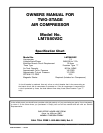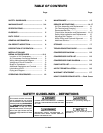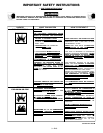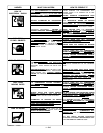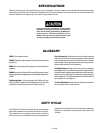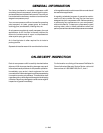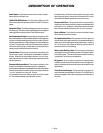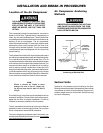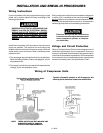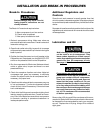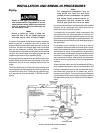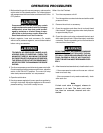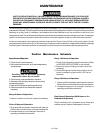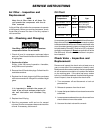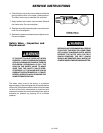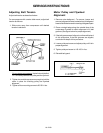
5—ENG
Refer to cover page for the specifications of your compressor. Use only a fuse or circuit breaker that is the same rating
as the branch circuit the air compressor is operated on. If the compressor is connected to a circuit protected by fuses,
use dual element time delay fuses, as noted in specification chart.
SPECIFICATIONS
GLOSSARY
CFM: Cubic feet per minute.
SCFM: Standard cubic feet per minute; a unit of measure of
air delivery.
PSIG: Pounds per square inch gauge; a unit of measure of
pressure.
ASME: American Society of Mechanical Engineers; made,
tested, inspected and registered to meet the standards of the
ASME.
California Code: Unit may comply with California Code
462 (L) (2)/(M) (2). Specification/Model Label is on the side
of the tank on units that comply with California Code.
Cut-In Pressure: While the motor is off, air tank pressure
drops as you continue to use your accessory. When the tank
pressure drops to a certain low level the motor will restart
automatically. The low pressure at which the motor automati-
cally re-starts is called “cut-in pressure.”
Cut-Out Pressure: When you turn on your air compressor
and it begins to run, air pressure in the air tank begins to build.
It builds to a certain high pressure before the motor automati-
cally shuts off - protecting your air tank from pressure higher
than its capacity. The high pressure at which the motor shuts
off is called "cut-out pressure."
To Lock Out Power: Place a lock on the line power switch
so no one else can turn on the power.
DUTY CYCLE
All DeVilbiss Air Power manufactured air compressors
should be operated on not more than a 50% duty cycle.
This means an air compressor that pumps more than
50% of one hour, is considered misuse, because the air
compressor is undersized for the required air demand.
Maximum compressor pumping time per hour is 30
minutes.
Improper electrical installation of this product
may void its warranty and your fire insurance.
Have circuit wiring performed by qualified per-
sonnel such as a licensed electrician who is
familiar with the current national electric code
and any prevailing local electrical codes.



